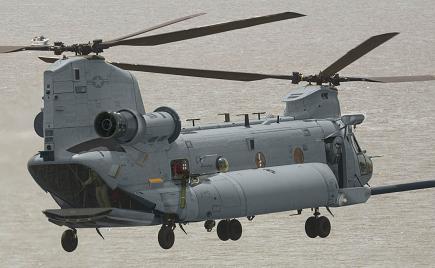Boeing’s HH-47 Chinook has won the US Air Force’s CSAR-X combat search-and-rescue competition, beating off the Lockheed Martin US101 and Sikorsky MH-92. The award is a blow to Sikorsky, which also lost the VXX US Presidential helicopter competition, in that case to the US 101.

Picture: Boeing
Lockheed Martin offered the US101, a version of the AgustaWestland EH101 to be assembled in the USA by Bell Helicopter. The aircraft incorporated upgrades under development for the VH-71A US Presidential helicopter version of the US101, including improved rotor blades, more powerful engines and updated cockpit.
Sikorsky offered the HH-92, based on the MH-92 under development for the Canadian Forces and a military derivative of the S-92. Features added to the digital fly-by-wire MH-92 included increased fuel capacity and gross weight, improved main rotor blades, uprated engines, refuelling probe and folding tail pylon.
The CSAR-X requirement is for 141 Block 0 aircraft, all to be upgraded later to a Block 10 configuration with features such as terrain following and terrain avoidance, passive wire detection, projectile approach warning and optical countermeasures. Bidders were encouraged to break Block 10 into production as soon as possible. Total value is put at some $10 billion.
The initial $712 million contract is for development of the Block 0 CSAR- X, including four test aircraft, to be followed by 51 production helicopters for delivery by 2014. Initial operational capability is scheduled for fiscal year 2012 for Block 0 and FY18 for Block 10, with the CSAR-X achieving full operational capability in FY24.
Performance requirements are to pick up two downed crewmembers at a threshold radius of 275nm (510km), with 325nm as the objective. This compares with less than 200nm for the HH-60. The Block 10 configuration requires increased performance, with a threshold 300nm radius at higher operating altitude.
Boeing argued its HH-47 – based on the US Army’s special-operations MH-47G - was closest to Block 0 “out of the box”. The HH-47 was the largest aircraft in the competition, although Boeing was able to demonstrate it met the 2h disassembly and 3h reassembly requirements for air transportability.
CSAR-X is expected to be followed by a competition for the 66-aircraft Common Vertical Lift Support Platform (CVLSP) programme, which calls for medium-lift helicopter to replace USAF Bell UH-1Ns used for VIP transport and missile site protection. Although separate procurements, CVLSP was envisaged as a less complex version of the selected CSAR-X platform, but selection of the HH-47 could result in a new competition.
Source: FlightGlobal.com



















